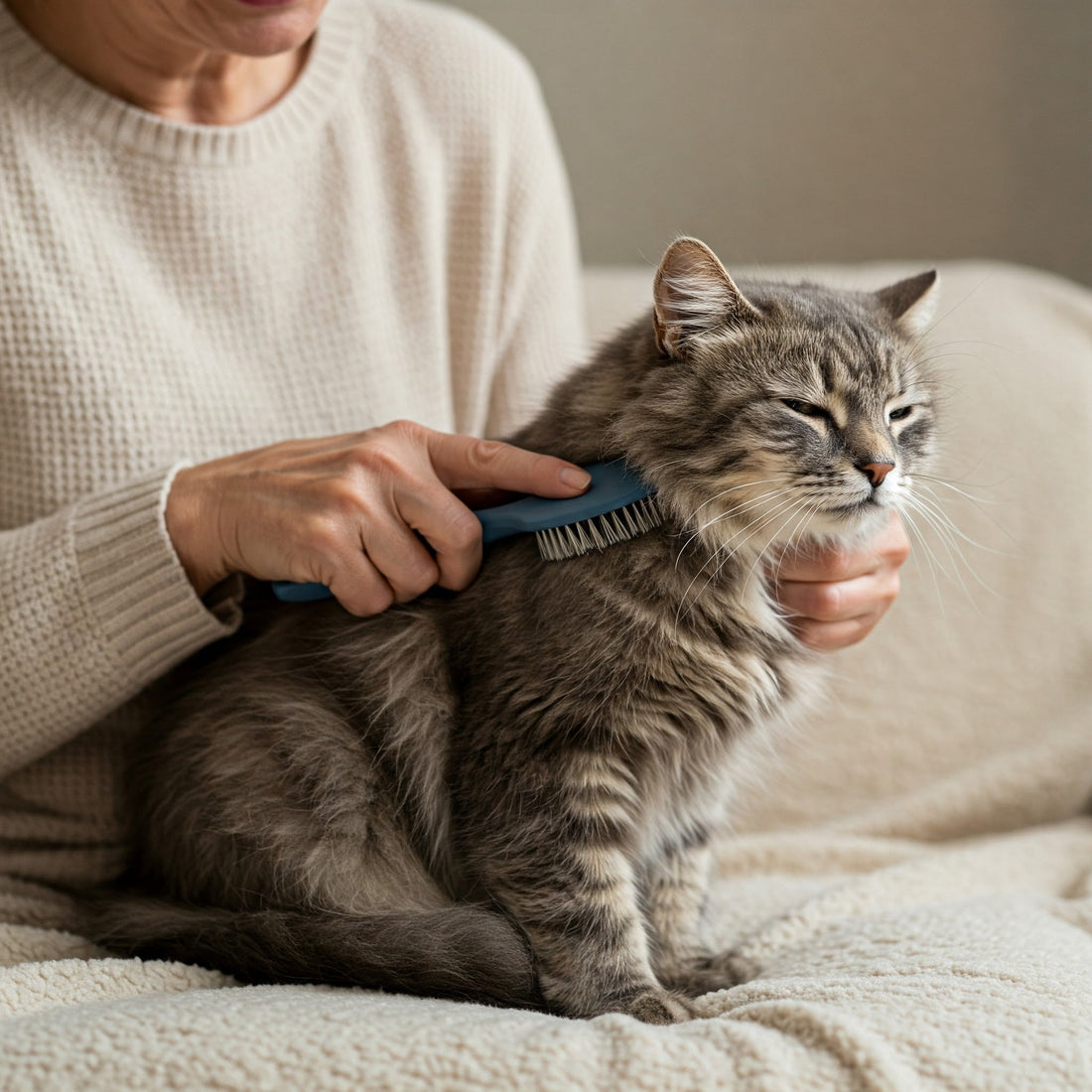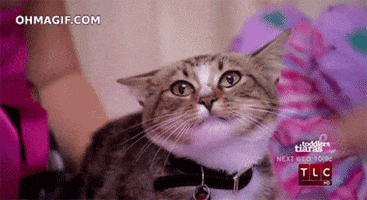
Senior Cat Grooming: Special Considerations and Gentle Techniques
Share
As cats enter their golden years, their grooming needs evolve in ways many pet owners may not anticipate. The sleek, self-sufficient groomer that once spent hours meticulously licking its coat may gradually become a cat that struggles to maintain its former fastidious habits. This change isn't simply about vanity—it's a critical aspect of senior feline health that demands our attention and adaptation. Understanding and addressing these shifting needs can mean the difference between a comfortable, healthy senior cat and one suffering from preventable skin conditions, painful matting, or other age-related complications.
Are You Grooming Your Senior Cat the Right Way?

The natural aging process affects cats much as it does humans, bringing physical changes that can significantly impact their ability to self-groom. Arthritis, a common ailment in older felines, makes the twisting and bending required for thorough cleaning increasingly painful. Dental issues, including missing teeth or gum disease, impair their ability to remove loose fur effectively. Some senior cats experience cognitive decline, essentially forgetting parts of their once-rigorous grooming routine. Additionally, aging skin becomes thinner and less elastic, while coat quality often deteriorates, becoming drier and more prone to matting. These physiological changes create a perfect storm for grooming-related health issues if not properly addressed by caring owners.
Matted fur represents one of the most common and serious grooming challenges in senior cats. What begins as a small tangle can quickly escalate into tight knots that pull painfully at the skin, potentially leading to sores, infections, or even restricted movement. Areas particularly vulnerable to matting include the belly, behind the ears, and around the hindquarters—places that require significant flexibility to groom properly. The discomfort caused by mats can create a vicious cycle, as the cat may avoid grooming altogether due to the pain, leading to further coat deterioration. Beyond the physical implications, poor coat condition can also indicate underlying health issues, making regular grooming sessions an important opportunity to monitor your senior cat's wellbeing.
Brushing an older cat requires a fundamentally different approach than grooming a younger feline. The stiff bristle brush that once worked perfectly may now irritate delicate senior skin. Sessions need to be shorter, gentler, and more frequent to prevent overwhelming an aging cat. Many owners find that switching to a soft rubber grooming mitt or a wide-toothed comb specifically designed for seniors makes the process more comfortable. It's crucial to let the cat's reactions guide the process—if they flinch, tense up, or attempt to leave, they're communicating discomfort that should be respected. Some cats may only tolerate being brushed in certain areas, requiring multiple short sessions to cover their entire body over several days.
For cats with significant matting, special care must be taken to address the problem without causing pain or stress. Never attempt to cut out mats with scissors, as it's dangerously easy to catch the thin, loose skin of an older cat in the blades. Instead, specialized tools like mat splitters or dematting combs can carefully work through tangles. In cases of severe matting, professional grooming assistance or even veterinary care may be necessary, as some cats require mild sedation to safely remove extensive mats without trauma. Prevention remains the best strategy, with regular gentle brushing being far preferable to dealing with established mats.
Bathing typically becomes a rare necessity for senior cats unless they have mobility issues that lead to accidents or get into something that can't be cleaned off with a damp cloth. When bathing is required, special accommodations must be made for an older cat's comfort and safety. The bathroom should be warm to prevent chilling, and a non-slip mat in the sink or tub helps prevent panic from slipping. Water temperature should be lukewarm, as senior cats regulate body temperature less effectively. Most importantly, the shampoo must be specifically formulated for cats—preferably a hypoallergenic, oatmeal-based variety that won't strip fragile skin of its remaining natural oils. The entire process should be as quick and calm as possible, with thorough drying afterward to prevent chilling.
Nail care takes on new importance for senior cats. As activity levels decrease, nails may not wear down naturally and can become overgrown, sometimes curling back into the paw pads—an extremely painful condition. However, many older cats become resistant to nail trimming due to arthritis or general stiffness. Wrapping the cat gently in a towel (the "burrito method") to expose one paw at a time can help, as can performing trims when the cat is sleepy and relaxed. Guillotine-style clippers often work better than scissors for seniors, providing more control to remove just the sharp tip of each nail. For particularly resistant cats, many veterinary clinics offer quick nail trim services that minimize stress for all involved.
Facial grooming often requires human assistance for senior cats. Eyes may develop more discharge that needs gentle cleaning with a soft, damp cloth (using a separate area of the cloth for each eye to prevent potential cross-contamination). Ears should be checked regularly for excess wax or debris, cleaned only on the outer visible areas with a veterinarian-approved solution—never inserting anything into the ear canal. Dental care becomes increasingly important as cats age, though many senior cats resist tooth brushing after a lifetime without it. Alternatives like dental treats, water additives, or specially formulated foods can help maintain oral health when traditional brushing isn't possible.
Creating a comfortable grooming environment can significantly improve the experience for both cat and owner. Placing a soft blanket on a stable surface at a comfortable height prevents strain on the human's back and makes the cat feel more secure. For arthritic cats, providing padded surfaces or even heated beds can relax muscles before grooming sessions. The timing of grooming matters too—choosing a time when the cat is naturally relaxed, perhaps after a meal or nap, often yields better cooperation. Keeping sessions brief and ending on a positive note with a favorite treat helps build positive associations.
Recognizing when professional help is needed represents an important aspect of responsible senior cat care. If a cat becomes consistently resistant to grooming or shows signs of distress (hiding, aggression, or excessive vocalization), these may be indications of pain or illness requiring veterinary attention. Professional groomers experienced with senior cats can be invaluable resources, often able to perform necessary grooming tasks more efficiently while minimizing stress. In some cases, veterinarians may recommend mild sedatives or anti-anxiety medications for particularly stressful but necessary grooming procedures.
Beyond the physical benefits, grooming sessions provide valuable opportunities to strengthen the bond with an aging feline companion. The gentle touch can be comforting, and the focused attention allows early detection of potential health issues like lumps, skin changes, or areas of sensitivity. Many owners find that adapting to their senior cat's changing grooming needs deepens their understanding and appreciation of their pet's life journey. With patience, adaptability, and proper technique, grooming can remain a positive experience that contributes significantly to a senior cat's quality of life in their golden years.
The emotional aspect of senior cat grooming shouldn't be underestimated. Owners often struggle with seeing their once fastidious pets unable to maintain their former standards of cleanliness. It's important to approach grooming sessions with empathy and without frustration, understanding that the cat isn't being difficult intentionally. Celebrating small victories—a successful nail trim, a mat-free week, or a particularly cooperative brushing session—helps maintain a positive outlook. Many cats seem to appreciate the assistance once they become accustomed to the new routine, often showing visible relief after a good grooming session.

Diet plays an often-overlooked role in maintaining a senior cat's coat health. As cats age, their nutritional needs change, and a diet lacking essential fatty acids can lead to dry skin and a dull coat. Consulting with a veterinarian about appropriate senior-formulated foods or supplements can improve coat condition from the inside out, making external grooming easier. Hydration is equally important—many senior cats drink less water than they need, contributing to skin dryness. Providing multiple water sources, including pet fountains which some cats prefer, can encourage better hydration.
The psychological benefits of regular grooming for senior cats extend beyond physical cleanliness. The tactile stimulation can be comforting, particularly for cats experiencing cognitive decline who may become disoriented or anxious. The routine provides structure, which many older cats find reassuring. For owners, the hands-on care offers tangible ways to express love and monitor their pet's wellbeing, which can be especially meaningful as a cat enters its later years.
Adapting tools and techniques to individual needs is key. A cat with severe arthritis may need a different approach than one with cognitive issues. Some may tolerate certain types of brushes but not others, or accept brushing in some areas but not all. Being observant and flexible, willing to adjust methods as needed, makes the process smoother for both parties. Keeping a log of what works and what doesn't can help identify patterns and preferences specific to each senior cat.

Ultimately, senior cat grooming is less about achieving perfection and more about maintaining comfort and health. A slightly scruffy but content older cat is far preferable to one that's perfectly groomed but stressed. The goal should be to do enough to prevent health issues while respecting the cat's changing abilities and tolerance levels. With patience, creativity, and plenty of gentleness, grooming can remain an important part of caring for a beloved senior feline companion through all of life's changes.
